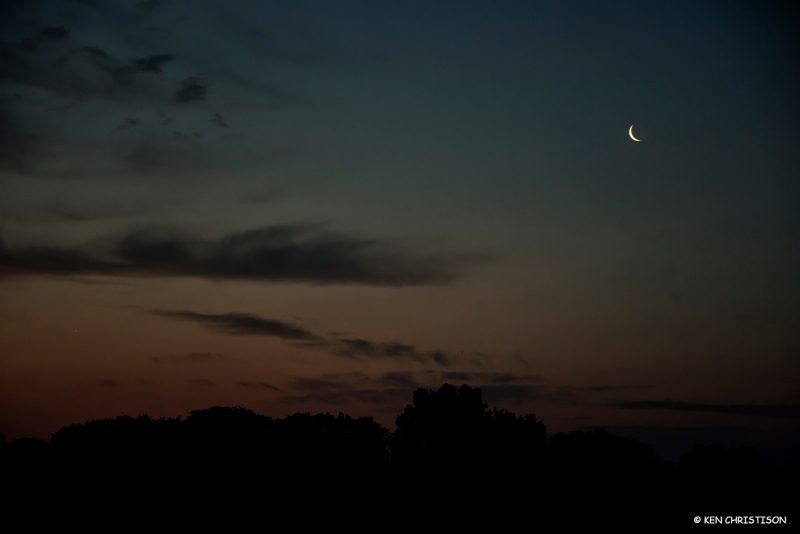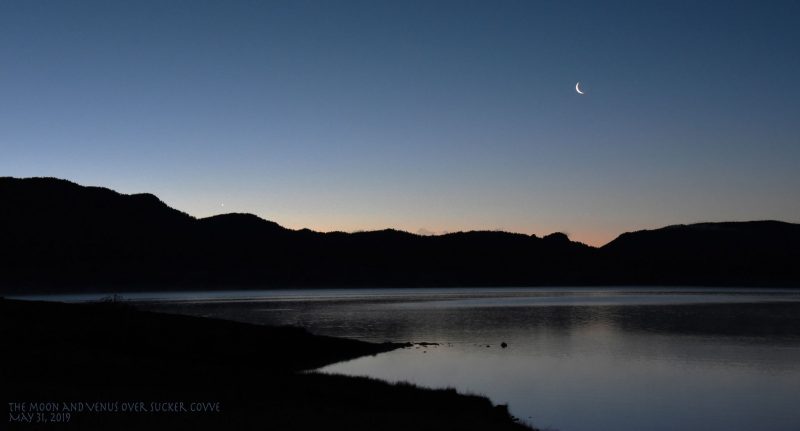A delicately beautiful sky scene awaits you on the mornings of May 30 and 31, plus June 1, 2019. On those mornings, you can use the waning crescent moon to find the planet Venus. Especially as viewed from Northern Hemisphere latitudes, this planet is now deeply buried in eastern twilight before sunrise. It’s a bit higher in the east before sunup as viewed from latitudes in the Southern Hemisphere. For all of us, although the moon and Venus rank as the second-brightest and third-brightest celestial bodies, respectively, after the sun, it’ll take a deliberate effort to spot them. You’ll need crystal-clear skies and an unobstructed horizon in the sunrise direction. Given favorable seeing conditions, you might witness the lovely close pairing of the moon and Venus on June 1. If the moon and Venus aren’t visible to the eye alone on that date, try your luck with binoculars.
Why are these early morning scenes so wonderful to see? There’s something heart-stirring about seeing bright objects exceedingly low in the sky. We promise you … if you look, and you spot them, you’ll be glad.
The Southern Hemisphere has a big advantage over the Northern Hemisphere for watching this early morning drama, here in late May and early June 2019. From the Southern Hemisphere, Venus doesn’t appear so deeply buried in the twilight; it’s higher in the east before sunup. Basically, this time, the farther south you are on Earth’s globe, the better you can see Venus. In fact, at far-northern latitudes – like Alaska – the moon and Venus won’t be visible at all; they rise after sunrise that far north on the globe. But at mid-northern latitudes and farther south, across the globe, you have a reasonably good chance of spotting the waning crescent moon and Venus at dawn.

From around the world, the moon will be the easiest to spot on May 30, because it’ll be a wider and brighter waning crescent, rising sooner before the sun (and Venus) on May 30 than on May 31 and June 1. The lit side of the lunar crescent will be pointing at Venus, so the moon acts as your arrow in the sky for locating Venus’ place near the horizon on May 30 and 31. The trick is to have patience, to wait for Venus to rise. It helps to know when Venus will rise into your sky. Here are the approximate rising times (presuming an unobstructed horizon) for various latitudes:
35 degrees north latitude: Venus rises one hour before the sun
Equator (0 degrees latitude): Venus rises 1 1/3 hours before the sun
35 degrees south latitude: Venus rises 1 2/3 hours before the sun
Click here for a recommended almanac that’ll more specifically give you Venus’ rising time into your sky.
Wherever you may be worldwide, use the lit side of the old moon to find Venus’ place near the horizon on May 30 and 31. Then try to remember where on the horizon you saw Venus on these two mornings. On June 1, a thinner and paler waning moon will be sitting lower in the sky and closer to Venus. From mid-northern latitudes, you might need to use binoculars to catch these two luminaries before sunrise June 1.

Bottom line: Good luck on catching the early morning spectacle on May 30, 31 and June 1, 2019. Two beautiful heavenly bodies – the moon and Venus – will be near the sunrise point, basking in the sweet glow of dawn.











